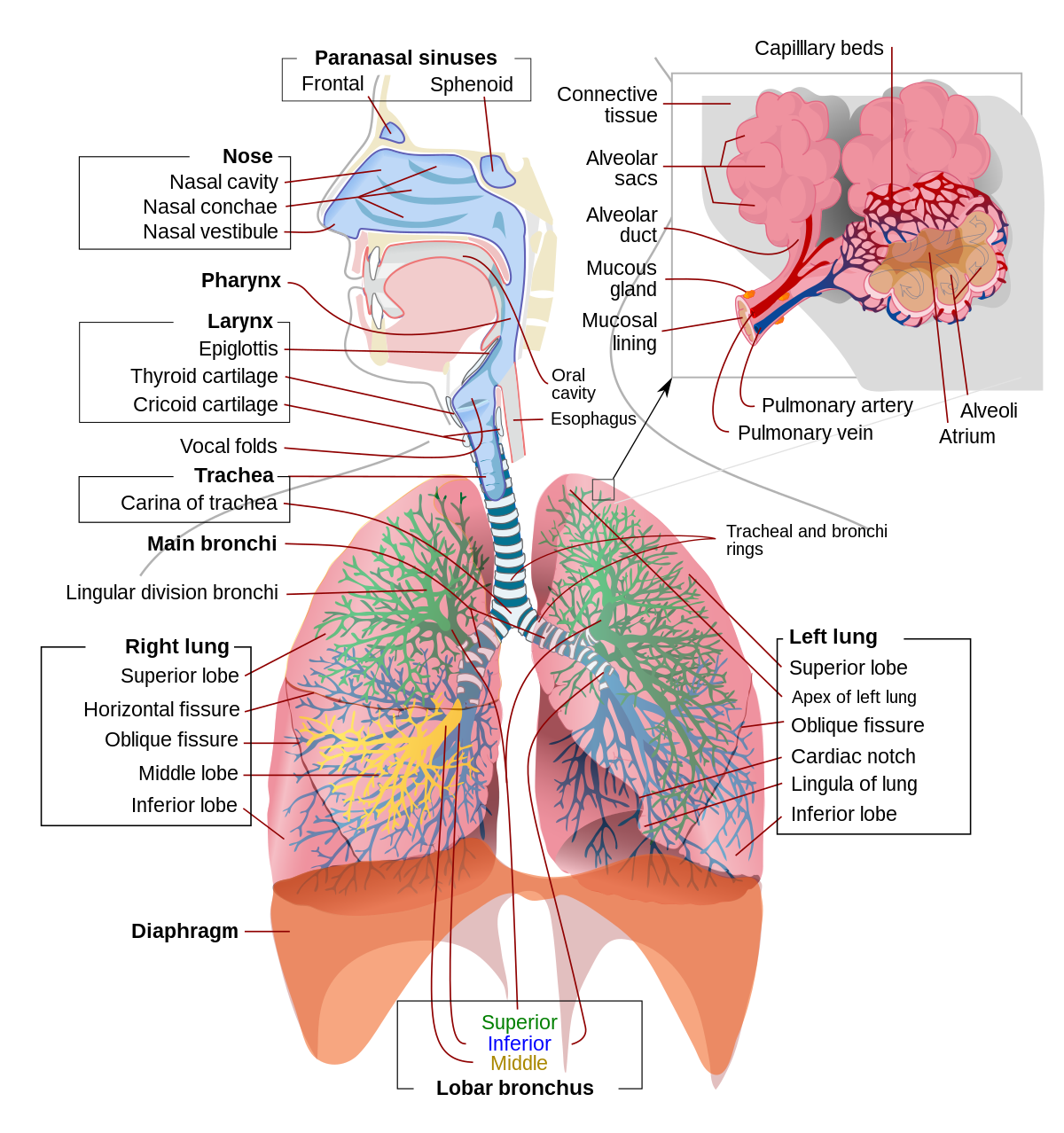
The respiratory system, a complex and intricate network of organs and tissues, is one of the most vital systems in the human body. It enables the exchange of gases, primarily oxygen (O2) and carbon dioxide (CO2), between the body and the external environment. This exchange is essential for sustaining life, providing the necessary oxygen for cellular respiration and expelling the waste product, carbon dioxide. In this comprehensive article, we will explore the anatomy, physiology, and crucial functions of the respiratory system.
Anatomy of the Respiratory System
The respiratory system consists of several interconnected components, each playing a specific role in the process of breathing and gas exchange:
1. Nasal Cavity
The process of respiration begins in the nasal cavity. The nose acts as a filter, humidifier, and temperature regulator for the incoming air. Tiny hair-like structures called cilia help trap foreign particles, preventing them from reaching the lower respiratory tract.
2. Pharynx
Located behind the nasal cavity, the pharynx serves as a common passage for both air and food. It directs air into the trachea and food into the esophagus.
3. Larynx (Voice Box)
The larynx is responsible for voice production. It contains the vocal cords, which vibrate when air passes through, producing sound. Additionally, the larynx houses the epiglottis, a flap-like structure that prevents food from entering the airway during swallowing.
4. Trachea (Windpipe)
The trachea is a tube that carries air from the larynx to the bronchi. It is reinforced with cartilage rings to maintain its structure and prevent collapse.
5. Bronchial Tree
The trachea divides into two bronchi—one leading to each lung. These bronchi further divide into smaller bronchioles, forming a tree-like structure that delivers air deeper into the lungs.
6. Lungs
The lungs are the central organs of the respiratory system. They are responsible for the exchange of gases between the air and the bloodstream. The right lung has three lobes, while the left lung has two to accommodate the heart.
7. Alveoli
At the microscopic level, the bronchioles terminate in small air sacs called alveoli. These are the sites where gas exchange takes place. Each lung contains millions of alveoli, greatly increasing the surface area available for gas diffusion.
8. Diaphragm and Respiratory Muscles
Breathing is facilitated by the diaphragm, a dome-shaped muscle located below the lungs. When it contracts, the thoracic cavity expands, reducing air pressure and causing inhalation. Exhalation occurs when the diaphragm relaxes, and the thoracic cavity decreases in volume.
Physiology of the Respiratory System
The respiratory system’s primary function is to facilitate the exchange of gases between the body and the environment. This process involves two critical phases:
1. Inhalation (Inspiration)
During inhalation, the diaphragm contracts and moves downward, while the intercostal muscles between the ribs expand the chest cavity. This expansion creates a lower pressure within the lungs compared to the external environment, causing air to rush in through the nose and mouth, down the trachea, and into the bronchial tree. Oxygen is then transferred from the alveoli into the bloodstream, binding to hemoglobin in red blood cells for transport throughout the body.
2. Exhalation (Expiration)
Exhalation is a passive process that occurs when the diaphragm and intercostal muscles relax. This reduces the volume of the chest cavity, increasing the pressure within the lungs. As a result, air is expelled from the lungs, carrying with it the waste product, carbon dioxide, which has been transported from the bloodstream into the alveoli for removal.
Functions of the Respiratory System
The respiratory system is indispensable for several crucial functions:
1. Gas Exchange
The primary function of the respiratory system is to facilitate the exchange of oxygen and carbon dioxide between the body and the external environment. Oxygen is essential for cellular respiration, the process by which cells generate energy. Carbon dioxide, a waste product of cellular metabolism, must be removed from the body.
2. Acid-Base Balance
The respiratory system helps regulate the body’s pH by controlling the elimination of carbon dioxide. Excess carbon dioxide can lead to acidosis (a decrease in blood pH), while insufficient removal can result in alkalosis (an increase in blood pH).
3. Vocalization
The larynx and vocal cords enable speech and vocalization. The modulation of airflow through these structures produces a wide range of sounds.
4. Immune Defense
The respiratory system includes mucus-producing cells and cilia, which help trap and remove foreign particles, pathogens, and pollutants that enter the airways. This function plays a vital role in protecting the body from respiratory infections.
Common Respiratory Disorders
Several conditions can affect the respiratory system, including:
1. Asthma
Asthma is a chronic respiratory condition characterized by inflammation and narrowing of the airways, leading to difficulty breathing, coughing, and wheezing.
2. Chronic Obstructive Pulmonary Disease (COPD)
COPD is a group of progressive lung diseases, including chronic bronchitis and emphysema, which obstruct airflow and make breathing difficult.
3. Pneumonia
Pneumonia is an infection of the lung tissue that can cause fever, cough, and difficulty breathing.
4. Lung Cancer
Lung cancer is a malignant growth in the lung tissue, often associated with smoking and exposure to carcinogens.
Conclusion
The respiratory system is an intricately designed and essential system in the human body. It ensures that oxygen, the breath of life, is delivered to cells while removing the waste product, carbon dioxide. Understanding the anatomy and physiology of this system is crucial for appreciating its role in sustaining life and maintaining overall health. Regular exercise, avoidance of smoking and air pollutants, and prompt treatment of respiratory disorders are essential steps in caring for this vital system and ensuring its continued function in the journey of life.



